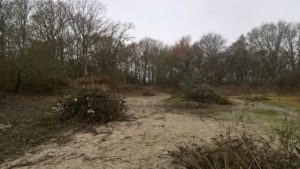From Shaun Marriott, London Wildlife Trust, Reserves Manager (South). <smarriott@wildlondon.org.uk> / Mob: 07710194268
There are plenty of upcoming opportunities to get involved with LWT’s excellent Braeburn Park site, which is just over the railway line from Hall Place and a 5 minute walk west from Crayford railway station. The Trust is always looking for new people to get involved with site management. No specialist knowledge or skills are required and equipment is provided. Volunteers are also sought to do butterfly counts along set routes at the reserve so as to monitor their numbers from year to year. Contact Shaun for more details. The site is open to the public at all times, and news of any interesting wildlife sightings will be much appreciated.
Access points are at the west end of Lower Station Road, Galloway Drive, the west end of the Braeburn Park estate, the old Rochester Way or a footpath down from the A2 bridge just after it crosses the railway line. See the map here:
Workdays during May will continue to be on Wednesdays and Thursdays, meeting 10.30 am at the tool store which is located a short distance past the bend on the old Rochester Way (roughly where it says ‘Braeburn Park Nature Reserve’ on the map), opposite the industrial estate. Alternatively, volunteers can catch up with the London Wildlife Trust work party at the work-site by contacting Shaun on the day. You will need to register.
The Trust is currently cutting back overgrown vegetation along various paths, building a new path along the low bank which runs along the wet area of the inclined sand cutting and working on small infrastructure tasks, including some steps. This will provide good access along the bank for walkers, with the aim of protecting the seasonally wet area.
Control of non-native species such as Goat’s rue will take place in the coming weeks, retaining the open areas which have been created by the Trust at various points around Braeburn Park, including the slopes surrounding the small playground and around the former sand pit banks. National Grid contractors recently loaned a mini digger with an operator to help with footpath and drainage improvements at the top of this area.
A steady increase in the number of casual visitors to Braeburn Park has been noted and feedback about improvements to paths, as well as habitats, is positive. More benches will be installed, along with some ‘what to see’ posters placed along paths and reptile refugia will be located at various hot-spots in early June so volunteers can begin monitoring slow worms, lizards and other species.
Butterfly recording has started and it is hoped that a full transect will be underway by early to mid-June, with monthly data forwarded to GiGL and other recording centres. Several bee orchids were in leaf recently on one of the acid grassland slopes, following Winter mowing of bramble and other scrub. The report about the recent London Wildlife Trust/Bexley RSPB collaborative bird walk here has been flagged up on the ‘Bexley Wildlife’ Facebook page. Lots of birds and people on the day, but better weather would no doubt have brought out more birds to be seen.
The London Natural History Society visit on 28th July will be part of a bioblitz event at Braeburn Park, currently at the planning stage, where there will be walks and other family-friendly activities on that day, looking at the varied habitats, birds, butterflies, wildflowers and bugs.
It is hoped that some Sunday workdays and other activities will be organised for June and details will be posted on the Trust’s Wildlondon website at http://www.wildlondon.org.uk/, as well as that of Bexley Wildlife.

